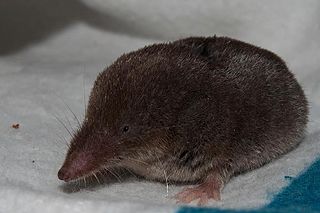
Mangifera is a genus of flowering plants in the cashew family, Anacardiaceae. It contains approximately 69 species, with the best-known being the Common Mango. The center of diversity is in subtropical and tropical South Asia and Southeast Asia, while the highest number of species occur in India. They are generally canopy trees in lowland rainforests, reaching a height of 30–40 m (98–131 ft).

Casuarina is a genus of 17 tree species in the family Casuarinaceae, native to Australia, the Indian subcontinent, southeast Asia, islands of the western Pacific Ocean, and eastern Africa. It was once treated as the sole genus in the family, but has been split into four genera.
Mangifera orophila is a species of plant in the family Anacardiaceae. It is a tree endemic to Peninsular Malaysia.

The tropical small-eared shrew is a very small mammal of the family Soricidae. The species is found in the eastern highlands of Chiapas, Mexico, and parts of Belize and Guatemala. Until recently, it was considered a subspecies of the North American least shrew, but it has gained species status. Its relationship with the Central American least shrew still remains to be studied.

Syngrapha is a genus of moths of the family Noctuidae.
Pagastiella is a genus of European non-biting midges in the subfamily Chironominae of the bloodworm family Chironomidae.

Syngrapha orophila is a moth of the family Noctuidae first described by George Hampson in 1908. It is found in western North America from extreme northern British Columbia and the Queen Charlotte Islands, south and east to southern Oregon, western Wyoming and Montana and western Alberta.

Melaleuca orophila, commonly known as needle bottlebrush or Flinders Ranges bottlebrush, is a plant in the myrtle family, Myrtaceae and is endemic to the eastern part of South Australia.. It is a medium-sized shrub with sharp-pointed, needle-like leaves and bright red bottlebrush flower spikes.

Aeolostoma is a genus of moths belonging to the subfamily Tortricinae of the family Tortricidae.

The Central American least shrew is a species of mammal in the family Soricidae. It is found in the highlands and mid-elevations from the western part of the northern coast of Honduras to central Costa Rica. It is found in El Salvador, Honduras, Nicaragua, and Costa Rica. It was considered to be a subspecies of the North American least shrew until 2002.

Coincya monensis is a plant species in the family Brassicaceae. Coincya monensis is native to western Europe and Morocco, but has been introduced in North America.
Muhlenbergia orophila is a grass species native to Guatemala and to Mexico as far north as the Distrito Federal. The type specimen was collected from an alpine meadow at an elevation of approximately 3750 m near the Summit of Sierra de las Cuchumantanes, a remote mountainous area in el Departamento de Huehuetenango in the western part of Guatemala.

Gardenieae is a tribe of flowering plants in the family Rubiaceae and contains about 586 species in 53 genera.
Pandemis orophila is a species of moth of the family Tortricidae. It is found in Uganda.
Pycnarmon orophila is a moth in the family Crambidae. It was described by Jean Ghesquière in 1940. It is found in the area of the former province of Orientale in the Democratic Republic of the Congo.
Lionneta is a genus of spiders in the family Oonopidae. It was first described in 1979 by Benoit. As of 2017, it contains 8 species, all of them from the Seychelles.

Cuphea oreophila also known as the sacred flower of the Andes is a Lythraceae perennial plant that grows into a small bush. Native to the Mexican state of Chiapas and to Guatemala, it was first described by TS Brandegee and Rimo Carlo Felice Bacigalupi in 1933.
Pardosa orophila is a species of wolf spider in the family Lycosidae. It is found in the United States and Mexico.
Eucalyptus orophila is a species of small tree or shrub that is endemic to East Timor. It has rough, scaly, flaky bark on the lower part of the trunk, smooth bark above, egg-shaped to lance-shaped adult leaves, flower buds in groups of seven, white flowers and barrel-shaped to bell-shaped fruit.
Weberbauera is a genus of flowering plants in the crucifer family Brassicaceae, native to the central Andes; Peru, Chile, Bolivia, and Argentina.










